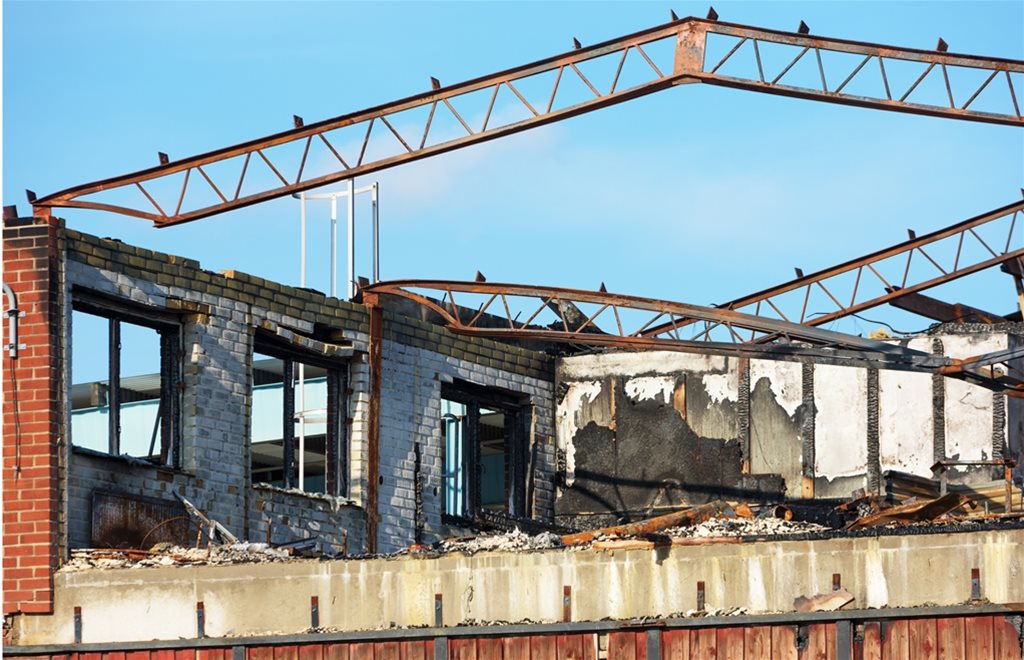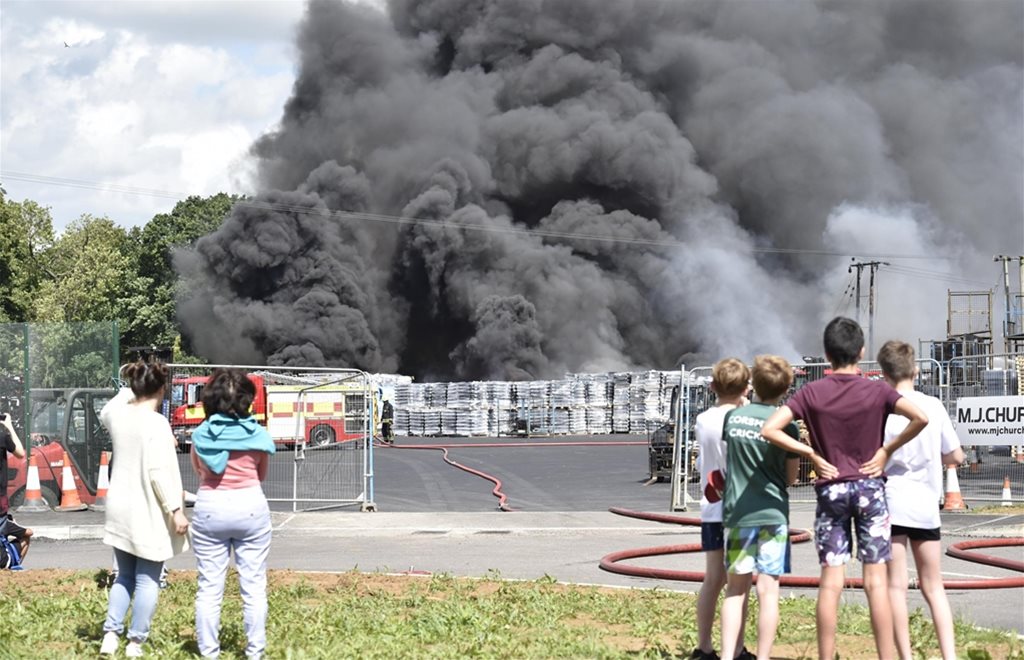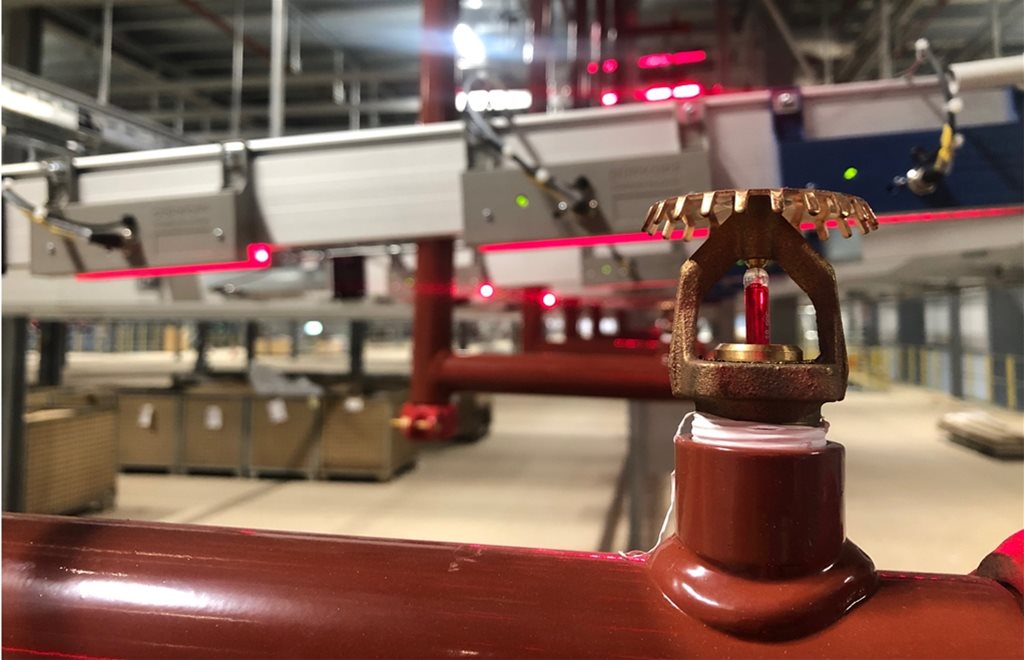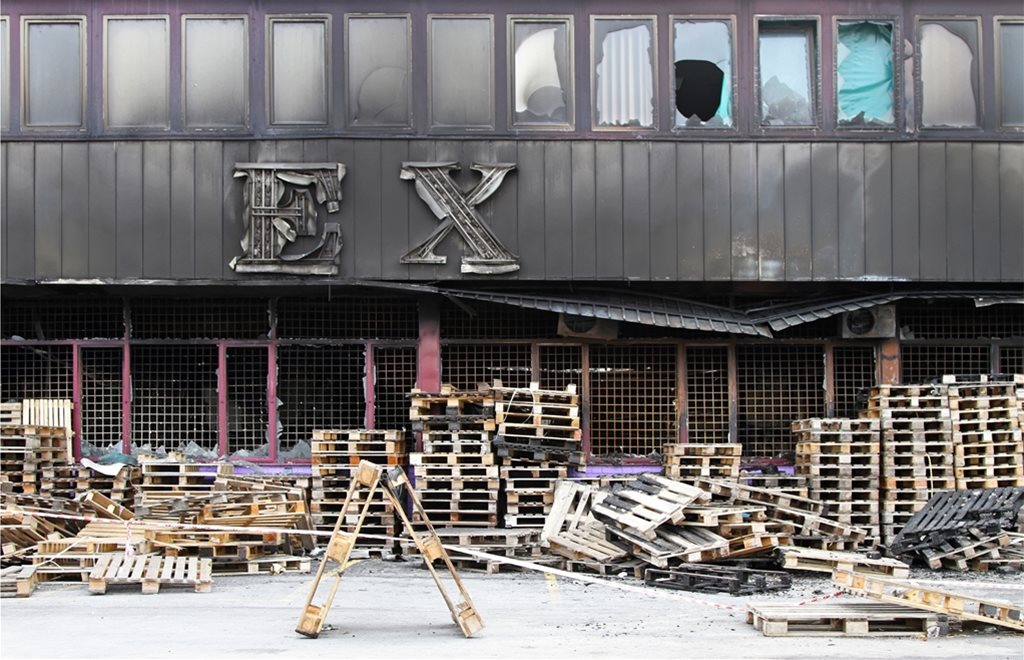Fire is indiscriminate, but Iain Cox shows that fitting sprinkler systems helps provide business protection and boost long term resilience
AS FIRES can happen at any time, with an impact that is much wider than often anticipated, resilience to this threat needs very serious consideration. Having sprinklers fitted helps protect businesses in the long term, safeguarding them against potentially disastrous losses that amount to £2.4m each day across the UK.
Why deliver a warehouse or school as cheaply as possible, but leave out fire safety measures – only to find five years later that it has been completely lost due to a fi re, resulting in greater costs?
Findings of a study1 carried out by the Business Sprinkler Alliance (BSA) revealed that only 16% of respondents considered the risk of fire a significant factor for their business and in their thought process when deciding whether to install sprinklers. The majority were uncommitted and/or relying on their insurance to cover any potential risk.
The impact and devastation caused by fire continues to remind us how vulnerable so many buildings are, and how in turn this can have far reaching consequences.
Recent blazes
On 30 May, a fire engulfed several buildings owned by the award winning, family run crisp manufacturer Corkers, which has an annual turnover of £10m, employs 80 staff and is one of Cambridgeshire’s most respected, community minded companies. The blaze, near Ely, saw the entire complex ravaged by fire in just two hours, creating smoke plumes which could be seen as far away as Bedford, and it closed local roads.
Up to 60 firefighters from three counties fought to contain it, described by group commander of Cambridgeshire Fire and Rescue Service, Paul Clarke, as ‘a very serious fire involving industrial units’. Corkers Crisps founder Ross Taylor said: ‘I am shellshocked, devastated... there are generations of work all just gone.’
A similar fate was suffered by London based snack manufacturer UK Snacks, which collapsed into administration nine months after a major fire destroyed areas of its warehouse in June 2018. While there may have been other contributing factors to its economic issues, the fire would in itself have caused disruption to its business.

Case study – Wavin, Chippenham
WHEN A small fire broke out overnight in July 2016 in a storage area at major plastics manufacturer Wavin in Chippenham, Wiltshire, an automatic sprinkler system extinguished the fire, preventing any major damage prior to the arrival of the fire service. With the fire safely extinguished, the business was back up and running the following morning – less than 24 hours later.
Fire and response
The fire was on the mezzanine level of Wavin’s large warehouse, at its manufacturing facility. It started when a small battery in a box of electrical components shorted and caught fire. The 2,000m2 building had a sprinkler system which activated and managed to suppress and extinguish the fire, stopping it from spreading. Had the fire not been contained, it would have caused significant damage to the storage facility.
Unmanned area
Paul Collins, production manager at Wavin, said: ‘If we had not had sprinklers in this unmanned area, the potential for other materials to ignite could have led to a much larger fire within the entire warehouse. This would have caused a major issue to our stock holding of injection moulded fittings and severely impacted the business and our customers.
‘Every building within our site at Chippenham, including all our high bay racked warehousing, has sprinklers fitted. There is no doubt the cost of installing sprinklers is far outweighed by the potential disruption and financial implication of a fire in one of our facilities. By having sprinklers installed, we are protecting our business by ensuring continuity to our customers and being a responsible employer.’

Business as usual
As one of the UK’s leading manufacturers of heating, plumbing and drainage products, Wavin has ensured that its business is resilient to fire, with sprinklers being a key component in that strategy.
Mr Collins continued: ‘Our day to day operations were unaffected by the fire thanks to the sprinkler system. As only the sprinkler heads above the fire operated, water was isolated to a small area of the warehouse, so the clean-up was dealt with very quickly.
Many companies do not prove resilient after a fire. While insurance can support the replacement of equipment, moving to an alternate location to maintain business operations and support continuity efforts can take an inordinate amount of time and effort. Unless trading can resume quickly, many businesses feel the financial pressure of maintaining cash flow and often struggle as a consequence.
Building fires such as these occur more frequently than people expect and have an impact that spreads far beyond that of owners and immediate occupiers. Approved Document B of the Building
Regulations, the fire safety guidance within the regulations, is based on a consideration of life safety impacts. However, as recent fires have shown, the impact is much wider, with economic, social and environmental implications. So, why are property protection and business resilience not given greater consideration, and why are businesses willing to take the risk?

Real impact
The Association of British Insurers predicts that UK businesses could stand to lose £10bn between 2010 and 2020 as a result of fire, which remains the leading cause of commercial property loss. Moreover, findings from the Chartered Institute of Loss Adjusters should be well noted by businesses, as its research shows that 43% of business interruption policies were under insured by an average of 53%.
Concurrently, businesses do not always accurately value what they own in terms of property, often underestimating the reality of the time it takes to recover from a fire. They fail to see the real impact of fire and leave themselves exposed.
Home Office figures2 show that over the past three years, the fire and rescue services (FRSs) in England have attended 26,800 fires in industrial and commercial buildings. A major fire can have a devastating impact, whether in offices, industrial buildings, healthcare facilities or hotels. Many businesses never recover, but the cost of fires in industrial and commercial buildings goes far beyond expense. With impacts on individual businesses and insured costs, fires cause significant economic, environmental and community costs, ultimately borne by the taxpayer.
Sprinkler delivery
To reduce the risk to life and the degree of damage in a fire, automatic sprinkler systems have been proven time and time again to be both effective and efficient in a wide range of fire scenarios and building types, affording greater levels of fire protection to people, property and the environment.
There is clear evidence from the National Fire Chiefs Council and the National Fire Sprinkler Network that sprinklers work. They collaborated on an investigation into the effectiveness and reliability of sprinkler systems.
In an independent report undertaken by Optimal Economics, thousands of incidents were analysed to provide detailed and comprehensive research into the activation and performance of sprinklers used to control fire in buildings.
The evidence indicates that sprinklers have an operational reliability of 94%. When called on to work, they have a very high reliability. Furthermore it is evident that when they do operate, they extinguish or contain fires on 99% of occasions across a wide range of building types3. This is why they are chosen to protect people, buildings and businesses, ensuring continuity and productivity.
Fitting a sprinkler system can prevent major financial and equipment losses, containing what could be a potential major disaster and turning it into a minor inconvenience. With proven and consistent reliability, this is a small price to pay to prevent the hard earned success of a business from going up in flames.
Recent research carried out by the Centre for Economics and Business Research has shown that each year fires in warehouses alone (which are only 15% of industrial and commercial building stock) cause a direct financial loss to business of £230m per year; cause a loss of £190m per year in gross domestic product through lost productivity and impacts up and down the supply chain; lose the Treasury £32m in tax receipts; and are the cause of 1,000 job losses.
The contrast between two buildings with and without sprinklers in a fire can be quite stark. In the event, many businesses with sprinklers suffer a minor interruption and find they are back up and running in a matter of hours. Those without can see five to six times the damage, and suffer longer spells of interruption. These systems make buildings and businesses resilient to fire incidents, because they control or extinguish a blaze before the FRS arrives. The impacted business can be operational within hours, avoiding the economic and social costs that can occur from a devastating fire
Iain Cox is chair of the British Sprinkler Association

References
- UK: Commercial and Industrial Attitudes Study 2018, Business Sprinkler Alliance.
- Home Office Fire Statistics – Other Buildings Fire Dataset, HM Government.
- Efficiency and Effectiveness of Sprinkler Systems in the United Kingdom: An Analysis from Fire Service Data, Optimal Electronics, May 2017.